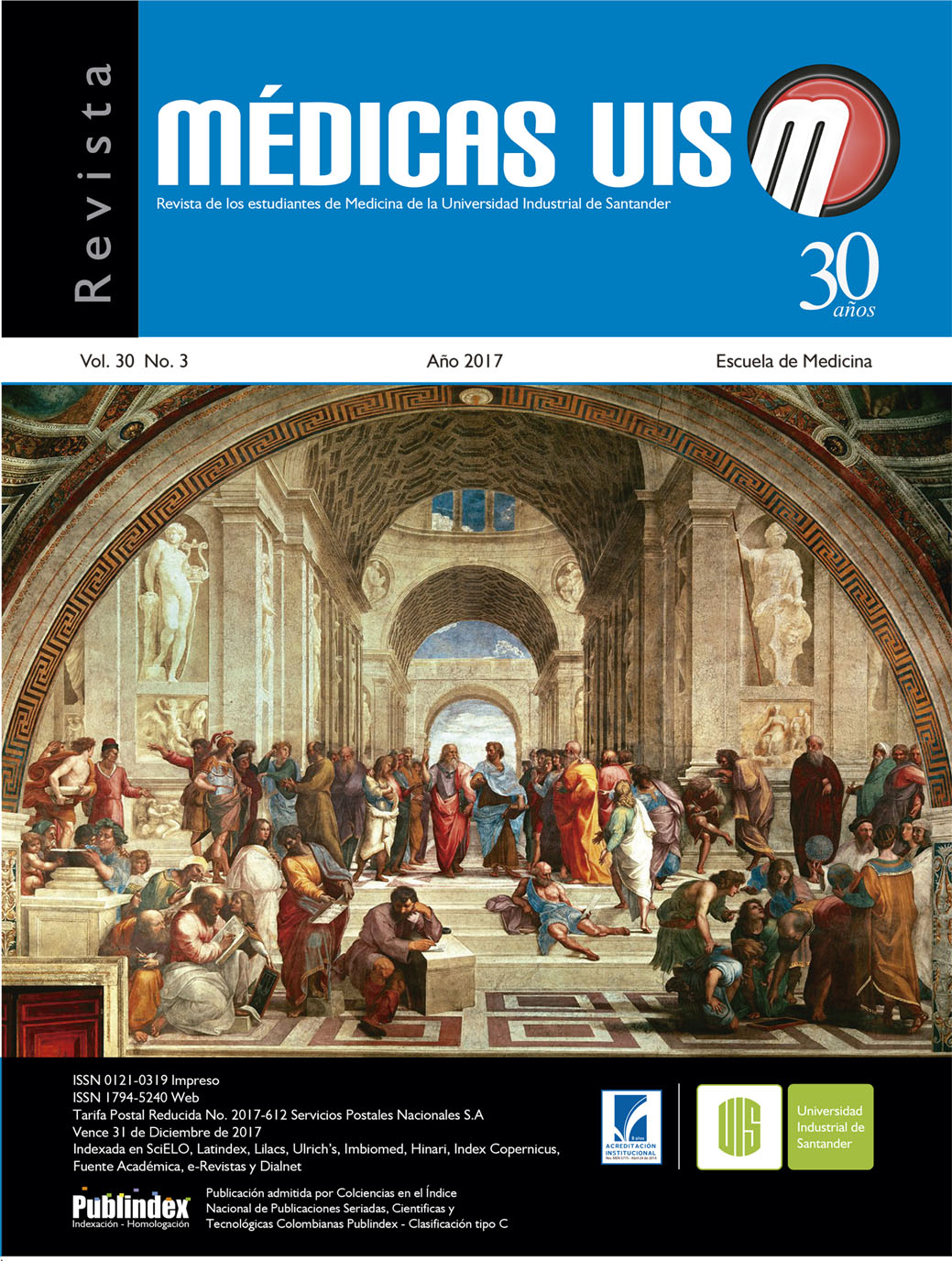Abstract
Introduction: drug interactions of anti-infectives can trigger renal disease; however, information on this effect is limited. Therefore, the identification, prevention and management of clinically relevant drug interactions are a key aspect in the achievement of therapeutic objectives in patients receiving anti-infectives. Objective: to identify and assess the clinical relevance of anti-infective drug interactions that causes kidney disease. methodology: systematic qualitative review of drug interactions of anti-infectives associated with renal disease. The clinical relevance of drug interactions was assessed according to the probability of occurrence and severity of the effect. The search was done in the PubMed/Medline database of articles published in english or spanish, between august 2006 and august 2016, using the following Mesh terms and Boolean Operators: “Renal Insufficiency” OR “ Anti-Bacterial Agents “OR” Drug Interactions “OR” HerbDrug Interactions “OR” Food-Drug Interactions “. Results: we identified 44 publications and nine were included. In these nine articles, 12 drug interactions associated with renal disease were identified. Combinations associated with renal disease were protease inhibitors/nifedipine, cobicistat/fenofibrate/pravastatin, tenofovir/metformin, macrolides/statins, statins/calcium channel blockers, quinolones/warfarin, valaciclovir/loxoprofen and fusidic acid/Pravastatin. Conclusions: protease inhibitors, macrolides and quinolones, as well as tenofovir, cobicistat, valaciclovir and fusidic acid can generate renal disease when used simultaneously with other drugs, especially with statins, calcium channel blockers, warfarin, metformin or loxoprofen. MÉD.UIS. 2017;30(3):101-9
References
2. Martínez-Múgica, C. Potential antimicrobial drug interactions in clinical practice: consequences of polypharmacy and multidrug resistance. Rev Esp Quimioter. 2015;28(6):282-8.
3. Model of Care Polypharmacy Working Group. Polypharmacy Guidance. Scotland: Quality and Efficiency Support Team & Scottish Government Health and Social Care Directorates; 2012. 47 p.
4. Institute for Safe Medication Practices. ISMP´s list of high-alert medications. Pennsylvania. 2007.
5. Organización Mundial De La Salud. Estrategia mundial de la OMS para contener la resistencia a los antimicrobianos. 2001.104 p.
6. Mizokami F, Mizuno T. Acute Kidney Injury Induced by Antimicrobial Agents in the Elderly: Awareness and Mitigation Strategies. Drugs Aging. 2015;32(1):1-12.
7. Khalili H, Bairami S, Kargar M. Antibiotics induced acute kidney injury: incidence, risk factors, onset time and outcome. Acta Med Iran. 2013;51(12):871–8.
8. Amariles P, Giraldo NA, Faus MJ. Interacciones medicamentosas: aproximación para establecer y evaluar su relevancia clínica. Med Clin (Barc). 2007;129(1):27–35.
9. Franco D, Henao Y, Monsalve M, Gutiérrez F, Hincapie J, Amariles P. Hypolipidemic agents drug interactions: approach to establish and assess its clinical significance. Structured review. Farm Hosp. 2013;37(6):539–57
10- Schmidt GA, Hoehns JD, Purcell JL, Friedman RL, Elhawi Y. Severe rhabdomyolysis and acute renal failure secondary to concomitant use of simvastatin, amiodarone, and atazanavir. J Am Board Fam Med. 2007;20(4):411–6.
11. Suttels V, Florence E, Leys J, Vekemans M, Van den Ende J, Vlieghe E, et al. A 68-year old male presenting with rhabdomyolysisassociated acute kidney injury following concomitant use of elvitegravir/cobicistat/emtricitabine/tenofovir disoproxil fumarate and pravastatin/fenofibrate: a case report. J Med Case Rep. 2015;9:190.
12. Baeza MT, Merino E, Boix V, Climent E. Nifedipine-lopinavir/ritonavir severe interaction: a case report. AIDS. 2007;21(1):119–20.
13. Aperis G, Paliouras C, Zervos A, Arvanitis A, Alivanis P. Lactic acidosis after concomitant treatment with metformin and tenofovir in a patient with HIV infection. J Ren Care.
2011;37(1):25–9.
14. Yue Z, Shi J, Jiang P, Sun H. Acute kidney injury during concomitant use of valacyclovir and loxoprofen: detecting drug-drug interactions in a spontaneous reporting system. Pharmacoepidemiol. Drug Saf. 2014;23(11):1154–9.
15. Patel AM, Shariff S, Bailey DG, Juurlink DN, Gandhi S, Mamdani M, et al. Statin toxicity from macrolide antibiotic coprescription: a population-based cohort study. Ann Intern Med. 2013;158(12):869–76.
16. Gandhi S, Fleet JL, Bailey DG, McArthur E, Wald R, Rehman F, et al. Calcium-channel blocker-clarithromycin drug interactions and acute kidney injury. JAMA. 2013;310(23):2544–53.
17. Nemoto C, Ikegami Y, Shimada J, Tsukada Y, Abe Y, Tase C. Acute renal failure caused by severe coagulopathy induced by the interaction between warfarin potassium and levofloxacin: a case report. J. Anesth. 2012;26(6):943–4.
18. Bachoumas K, Fiancette M, Lascarrou JB, Lacherade JC, Leclair F, Reignier J. Fatal rhabdomyolysis following the co-prescription of fusidic acid and pravastatin. Med Mal Infect. 2015;45(10):417–9.
19 Sugimoto T, Yasuda M, Sakaguchi M, Koyama T, Uzu T, Kashiwagi A, et al. Oliguric acute renal failure following oral valacyclovir therapy. QJM. 2008;101(2):164–6.
20. Temesgen Z. Cobicistat, a pharmacoenhancer for HIV treatments. Drugs Today (Barc). 2013;49(4):233–7.
21. Negredo E, Rey-Joly C. Cardiovascular risk and human immunodeficiency virus infection: A new clinical challenge. Med Clin (Barc). 2010;135(5):209–11.
22. Fisman EZ, Tenenbaum A. A cardiologic approach to non-insulin antidiabetic pharmacotherapy in patients with heart disease. Cardiovasc Diabetol. 2009;8:38.
23. Chang CT, Chen YC, Fang JT, Huang CC. Metformin-associated lactic acidosis: case reports and literature review. J Nephrol. 2002;15(4):398–402.
24. Rocha A, Almeida M, Santos J, Carvalho A. Metformin in patients with chronic kidney disease: strengths and weaknesses. J Nephrol. 2013;26(1):55–60.
25. Sagawa N, Tsurutani Y, Nomura K, Okuyama T, Kondo M, Sata A, et al. Acyclovir-induced neurotoxicity and acute kidney injury in an elderly diabetic patient treated with valacyclovir: report of a case. Nihon Ronen Igakkai Zasshi. 2014;51(6):581–5.
26. Uwai Y, Taniguchi R, Motohashi H, Saito H, Okuda M, Inui K. Methotrexate-loxoprofen interaction: involvement of human organic anion transporters hOAT1 and hOAT3. Drug Metab Pharmacokinet. 2004;19(5):369–74.
27. Morgan T, Anderson A. The effect of nonsteroidal antiinflammatory drugs on blood pressure in patients treated with different antihypertensive drugs. J Clin Hypertens (Greenwich). 2003;5(1):53–7.
28. Rodríguez JJ, Franco E, Delgado F, Villalobos F. Epilepticus status and valaciclovir in chronic renal failure. Med Clin (Barc). 2004;123(10):399.
29. Glesby MJ, Aberg JA, Kendall MA, Fichtenbaum CJ, Hafner R, Hall S, et al. Pharmacokinetic interactions between indinavir plus ritonavir and calcium channel blockers. Clin Pharmacol Ther. 2005;78(2):143–53.
30. Leor J, Matetzki S. Ofloxacin and warfarin. Ann Intern Med. 1988;109(9):761.
31. Jones CB, Fugate SE. Levofloxacin and warfarin interaction. Ann Pharmacother. 2002;36(10):1554–7.
32. García-Rodríguez, J. A., Zufiaurre, N. G., & Bellido JM. Ácido fusídico. Rev Esp Quimioter. 2003;16(2):161–71.
